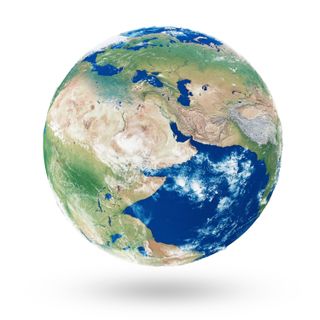Estimated Time for When the Continents Become One Again
Will in that location ever exist another Pangaea?

Only earlier the dawn of the dinosaurs — roughly 251 million years ago — Earth's continents abutted one another, merging to form the supercontinent Pangaea. That land mass, which straddled the equator like an ancient Pac-Man, eventually divide into Gondwana in the south and Laurasia in the due north.
From there, Gondwana and Laurasia separated into the seven continents that nosotros know today. But the constant movement of Earth's tectonic plates raises a question: Will there ever be some other supercontinent similar Pangaea?
The answer is yes. Pangaea wasn't the starting time supercontinent to form during Earth's 4.5-billion-year geologic history, and it won't be the last.
Related: What Is Plate Tectonics?
"That's the 1 part of the debate that there isn't much debate over," Ross Mitchell, a geologist at Curtin Academy in Perth, Australia, told Alive Science. "But what 'the next Pangaea' will look like … that's where opinions diverge."
Geologists agree that at that place is a well-established, fairly regular bicycle of supercontinent germination. It'south happened three times in the past. The first 1 was Nuna (also chosen Columbia), which existed from about i.eight billion to 1.3 billion years ago. Next came Rodinia, which dominated the planet between ane.2 billion and 750 1000000 years ago. So, in that location's no reason to think that another supercontinent won't form in the futurity, Mitchell said.
The convergence and spreading of continents are tied to movements of tectonic plates. The World'due south crust is divided into ix major plates that glide over the drape, the liquid layer that sits betwixt the core and the semi-solid crust. In a process chosen convection, hotter material rises from near the Globe's core toward the surface, while colder curtain stone sinks. The rising and falling of mantle material either spreads plates apart, or forces them together by pushing 1 under another.

Scientists can rail tectonic plate movements using GPS instruments. Only in order to slice together what these plates were up to millions of years ago, paleogeologists have to turn to natural magnets in the Earth's crust. As hot lava cools at the junction where two plates are colliding, some rocks in the lava containing magnetic minerals, such as magnetite, align with Earth'southward current magnetic fields. As the then-cooled rock moves via plate tectonics, scientists can use that alignment to calculate where, in terms of latitude, those magnets were located in the past.
According to Mitchell, a new supercontinent forms every 600 million years or and then, simply that cycle might be speeding up. This suggests that the next Pangaea, dubbed Amasia (or Pangaea Proxima) would form sooner than nosotros expect. Mitchell thinks the cycle is speeding upward because the Earth'due south internal estrus — hoarded in the planet's core since the time of its formation — is dissipating, pregnant that convection is happening faster.
"Given that the heyday of Pangaea was probably 300 meg years ago, Amasia'southward would be 300 million years from at present," Mitchell said. "Simply information technology could form as soon as 200 million years from now."
However, predicting the birth year of Amasia isn't so simple.
"The difficult thing about predicting the Pangaea of the future is that yous tin can't take nowadays-twenty-four hour period plate motions and hit fast-forward," Mitchell said. Plate motions can change unexpectedly, with imperfections in the seafloor causing plates to veer from their trajectories.
Shortly, California and eastern Asia are converging toward Hawaii, while N America is moving farther and farther away from Europe, Matthias Green, an oceanographer at Bangor Academy in the United Kingdom, told Live Scientific discipline. Meanwhile, Australia is drifting n on a collision course with Korea and Japan, and Africa is rotating northward toward Europe. These movements, of class, are happening at the rate of centimeters per year, almost the speed that your hair and nails grow.
Mitchell and Green said there are a handful of prevailing ideas nigh what the adjacent geologic game of "Tetris" might expect like. The Atlantic Ocean could shut upwardly, with northern Canada crashing into the Iberian Peninsula and Southward America colliding with southern Africa roughly where Pangaea used to be. Or the Pacific Bounding main could disappear, subsumed by Asia and N America. Mitchell had one additional, out-of-the-box hypothesis: that North America and Asia might move north to converge over the Arctic, quashing the Chill Ocean.
So, how might the formation of the next Pangaea affect life on Earth (assuming there's withal flora and fauna 300 million years from at present)?
It will definitely change existing weather condition and climate patterns and affect existing biodiversity, Light-green said. "The largest mass extinction event to engagement happened during Pangaea," Green said. "Was that because we were on a supercontinent? Or coincidence?"
He's referring to the Permian-Triassic extinction, dubbed "the Slap-up Dying," when ninety% of the globe'due south species died out 250 million years ago. Only after Pangaea formed, ii major volcanic eruptions spewed large amounts of methane and carbon dioxide into the atmosphere, which may have contributed to the mass die-off. Only scientists aren't in agreement about whether plate tectonics and the convection processes that formed Pangaea are linked to these critical volcanic events.
It's unclear what's in store for life on Earth when the next supercontinent forms. Simply, thanks to scientists like Mitchell and Green, we may at to the lowest degree know what our atlases should look like a few hundred million years from now.
Original article on Live Science.
johnsonsuccionoth.blogspot.com
Source: https://www.livescience.com/63753-will-there-be-another-pangea.html
0 Response to "Estimated Time for When the Continents Become One Again"
Post a Comment